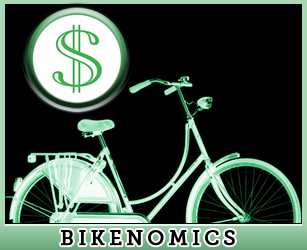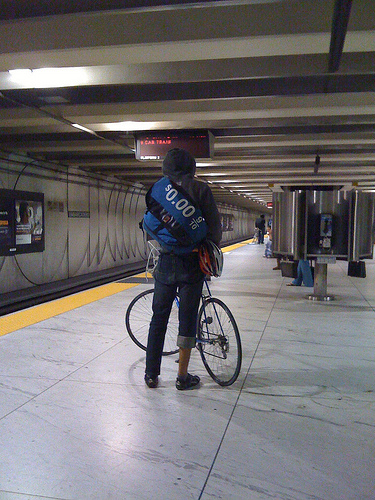 This is the fifth column in a series focusing on the economics of bicycling.
This is the fifth column in a series focusing on the economics of bicycling.
Libya. Bahrain. Iraq. Afghanistan. Canada. Fukushima. North Dakota. The Gulf Coast. Pennsylvania.
Each of these stories stands alone as an urgent parable about our increasingly fragile reliance on affordable, plentiful energy.
Take them together, and the myth of abundant fuel that our economy relies on falls to pieces all at once.
What if there were some source of energy that could replace a substantial part of our current consumption?
One that didn’t rely on coal, or on corn, or on fast-track investment in renewables? One with negligible direct costs, that paid us back, equitably and many times over the more we used it?
I mean the bicycle, of course.
The idea doesn’t seem so absurd when you realize how much of our energy crisis is a transportation crisis.
Consider this: close to half of U.S. oil use today is in the form of gasoline. Most of this gasoline goes directly towards fueling automobiles.
We’re talking about 377 million gallons every single day. That’s a bit more than a gallon per U.S. resident per day, including the 1/3 of us who don’t have driver’s licenses. That’s more than the daily amount of water most of us drink.
With gas now rising towards $5 a gallon across the country — and still going — it’s becoming very clear that we can’t afford it any more. At least not so much of it.
What’s more, we cannot afford the trillions billions of dollars we spend every year protecting our energy sources abroad.
We can’t afford to maintain the highways that car transportation depends on to make any sense.
We are increasingly unable to carry the economic burden of the sprawl that results from our reliance on the long-distance motor travel all this energy makes possible.
And the human costs of war — and, increasingly, of car dependence — are something we’ve never been able to truly afford.
And that’s the crux of it. As much as rising gas prices are straining and angering us, we are already paying prices much higher than the famously high costs in, say, Europe, where drivers currently shell out between $7 to $10 per gallon. By a 2003 analysis that considered all the factors that go into each gallon of gas, we paid as much as $15 per gallon, all told. And that was nearly a decade ago.
We already pay far more than we think, even if we never get in a car. We just don’t see it — even though the bill comes around every April.
The trillion dollar question is: can all this energy possibly be worth it?
For a brazen few, it’s a bonanza.
But for the rest of us, the fog is clearing and the true costs are starting to come into view. Over the last 60 years we’ve variously fallen, leaped, and been pushed headlong into daily dependence on something we will never really be able to pay for — always with some of us struggling more than others.
 Combining bikes with transit can extend your range even further.Photo: CosmoThere’s no easy way out at this point. But if we approach energy as a transportation issue rather than a geopolitical one, we can at least start to see a way through it.
Combining bikes with transit can extend your range even further.Photo: CosmoThere’s no easy way out at this point. But if we approach energy as a transportation issue rather than a geopolitical one, we can at least start to see a way through it.
Instead of pushing gas prices back to even more artificial lows, we need to invest that money that is normally all tied up in oil into bikes … and places to ride them.
Bicycling makes a lot of sense in a landscape built for cars. Bikes are fast and flexible enough to fill the gap between transforming spread-out driving destinations to walkable, accessible communities. With 40 percent of our driving trips spanning less than two miles, the distances are feasible — so long as the roads aren’t designed to be terrifying.
It takes minimal investments, mostly in mitigating the effects of sharing space with motor vehicles, for bicycling to almost overnight become a convenient and attractive choice for many, many people.
Even so, the most powerful US transportation organization, the American Association of State Highway and Transportation Officials, has just made a move to curtail bike infrastructure spending. The outcry from advocates and states has stalled but not thwarted this effort. Clearly the political pressure is powerful to keep throwing money into increasing rather than decreasing our demand for and daily reliance on not-so-cheap energy.
Fortunately, once enough of us are out there riding, the streets become safer and there’s less of a need to wait around for bike lanes to show up. One blogger in Dallas, Tex. ran the numbers and found that the $500 he would spend on six tanks of $4 gas would quickly subsidize the purchase of a sweet city bike. As gas prices climb, we’ll undoubtably see a surge in people acting on similar calculations, just as we did in 2008, when gas hit $4 for the first time.
The oil economy is vast, opaque, expensive, and sublimely beyond most of our ability to comprehend, much less control or escape.
The bicycle economy exists, meanwhile, on a human, mostly local scale. It’s something each of us can concretely take hold of, in our own way and for our own reasons. It offers real freedom and also the opportunity to make real connections.
Bicycling can’t save us from our energy crisis. At this point, nothing can. But it does point us toward a way to get through it with grace and possibly even build ourselves lives, communities, and a transportation system that we can truly afford.


